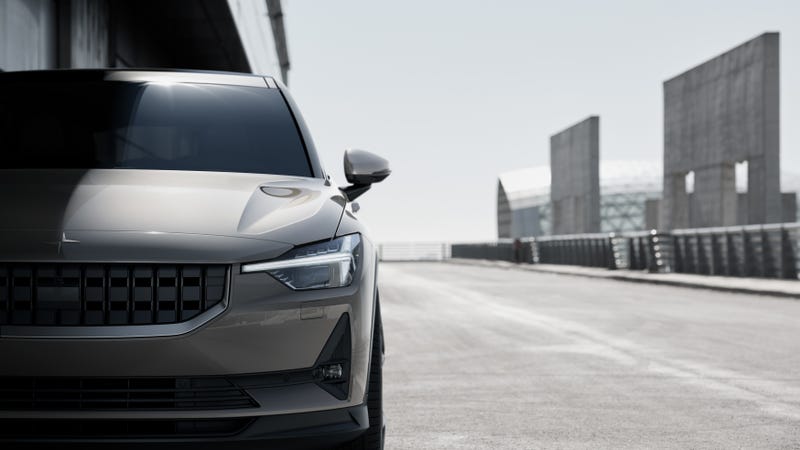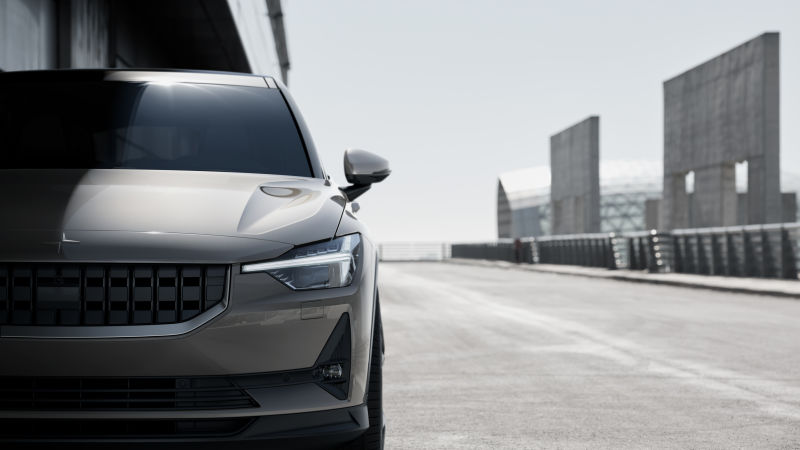
The Polestar 1 is a hybrid sports car priced like a supercar, at $155,000; the Polestar 2 is an all-electric sedan priced like a Tesla Model 3, starting at $45,000. The Polestar 2 (which debuted this morning) is also cool as hell. Should Tesla be a little worried? Yes, Tesla should be a little worried.
Polestar, of course, is owned by Volvo, itself owned by Geely. After a bit of a wobble in the 2000s, Volvo could have found itself in the same situation as now-defunct Saab, which declared bankruptcy in 2011. Instead, Geely bought the company, and has completely revitalized the Swedish marque, with Volvo selling over 600,000 cars last year, a record for them. The company also opened a huge new manufacturing facility in South Carolina, a well-timed move given Trump’s trade war.
Volvo’s completed its re-birth by building good cars, and by doing the opposite of what Elon Musk has been doing with Tesla, building its business quietly and not with a whole lot of fanfare. Do you know who the CEO of Volvo is? You don’t, because Håkan Samuelsson, with 3,690 followers as of this writing, doesn’t waste his time on Twitter. (You could argue that Elon’s Twitter presence can be a good thing—he’s frequently responded to valid customer complaints, for example, and it’s free publicity for Tesla—but his Twitter use has also gotten him in deep trouble with the SEC, seen him call a Thai cave rescuer a “pedo,” and at one point even had Nazis thinking he was dogwhistling to them, so that argument is increasingly hard to make.)
Volvo’s interiors are also the nicest in the business, and its well-earned reputation for safety has made the XC60 and XC90 go-tos for affluent-ish people with families.
Which brings me to Polestar, Volvo’s performance arm, its version of AMG or TRD. The Polestar 1 is set to reach customers this year, with the Polestar 2 to follow sometime after. Just 500 Polestar 1s will be produced, however, with all 200 of the examples for North America already spoken for. The Polestar 2, though, will be mass-market, with 400 horsepower, a sedan squarely aimed at Tesla Model 3 customers.
Advertisement
Its $45,000 starting price is the biggest indication that Polestar is getting down to business, as Tesla has said that the base Model 3 will start at $35,000 but actually hasn’t sold any at that price, instead selling up to now higher-priced performance versions.
Further, Polestar will be adopting a unique dealership model in the U.S., with no inventory, no service center, just a small showroom and some reps. That means that Polestar dealers will have to invest a little over a half-million dollars to open a “dealership,” as opposed to ten times that or more to open a more conventional dealership. That somewhat mirrors what Tesla has been doing, though Polestar “dealerships” won’t all be owned by the company, like Tesla’s are.
From Automotive News:
Polestar will operate stores ranging from 2,000 to 2,500 square feet — referred to as “spaces” — in high-traffic urban locations such as downtown districts, mixed-use developments and shopping centers.
“We want to make sure that our retail partners have high throughput,” [Polestar North American boss Hembrough] said, referring to the selection of its store sites. “High throughput obviously means high profitability.”
A lower retail investment should also help with retailer profitability.
“There isn’t a lot being asked of dealers regarding corporate identity, or build-out,” Hembrough said.
Advertisement
That strategy aligns with a bigger Volvo strategy of shifting the way we buy cars, through either a subscription model—like the troubled but (sorry) innovative Care by Volvo system—or through online sales. Automotive News says that Polestar will offer its cars for sale, lease, or subscription, somewhat of a shift from Polestar’s previous position on the matter, when they implied that all of its cars would be subscription-only.
One important question somewhat unanswered for now is whether you will be able to haggle, since Polestar customers will be buying/leasing/subscribing to the car exclusively online. That seems unlikely, much like Tesla doesn’t let customers haggle—the price is the price, something Tesla’s been able to get away with for now because demand has been so huge. But will demand for the Polestar be the same? It could be. The Polestar 1, for example, sold out its initial run of 500 examples pretty quickly.
A spokesman for Polestar said that there will be no haggling on the subscription prices, but the company is still sorting out details for buyers and lessees, mostly because regulations vary state-by-state and Polestar must go through each one of them. As for that subscription model, Hembrough, the North American Polestar exec, said that the initial coverage was overblown, in part their fault:
“We were amplifying subscription as a possibility,” Hembrough said. People “might have run away with the idea that was the only channel. There’s still some misunderstanding in the retail network among dealers as well.”
Hembrough expects Polestar 2 sales to have a 70-30 percent split between leasing/subscriptions and sales.
Advertisement
Volvo people consistently tell me that Care by Volvo is hugely attractive to young buyers, and I believe them, since everyone hates dealerships and I, for one, a Millennial myself, prefer to buy things online, as opposed to walking into a brick-and-mortar store and talking with a salesperson who may or may not know what the hell they’re talking about, and who may or may not have an ulterior motive.
Volvo and Polestar are betting, in other words, that its product will sell itself. And they might be right! Especially since demand for the Model 3 might have reached its limit, which is Tesla’s next real problem.
And Polestar isn’t stopping with the Polestar 2. The Polestar 3, an electric SUV, is next, followed by a crossover and a roadster, the latter car we first learned about Sunday. Those promises can sound a little Elon-esque—is Polestar also building a semi next??—but all we’ve seen from Polestar is the kind of slow and steady build-up that it historically takes to win in the car business. And the company is backed by Geely, one of the biggest car companies in the world, with some of the deepest pockets.
Advertisement
One huge advantage that Tesla has, for now, is its Supercharger network of fast-charging stations, which has been rolling out across the U.S. for years now. Polestar has nothing of the sort, but in the beginning at least, most of these cars will probably be sold in California, where quite a lot of EV infrastructure already exists. Polestar also has time, as the Polestar 1 is a hybrid and the all-electric Polestar 2 will not get delivered before 2020, and probably later.
I wouldn’t be surprised, in other words, if we all woke up tomorrow 20 years older, with Tesla—subsumed by its debt—a distant memory and Polestar having taken over the world.













